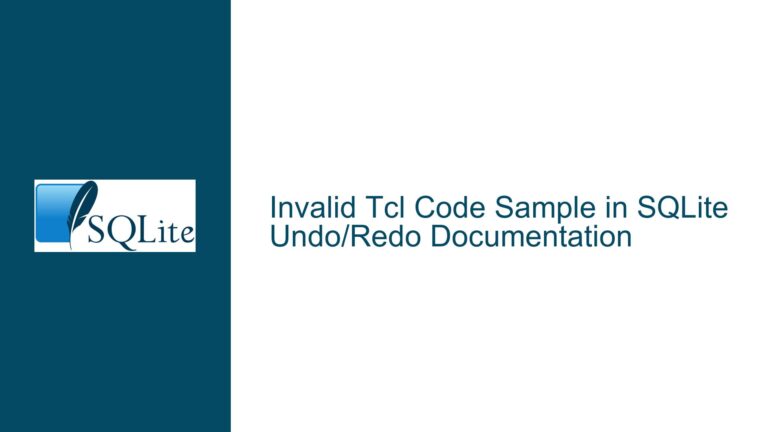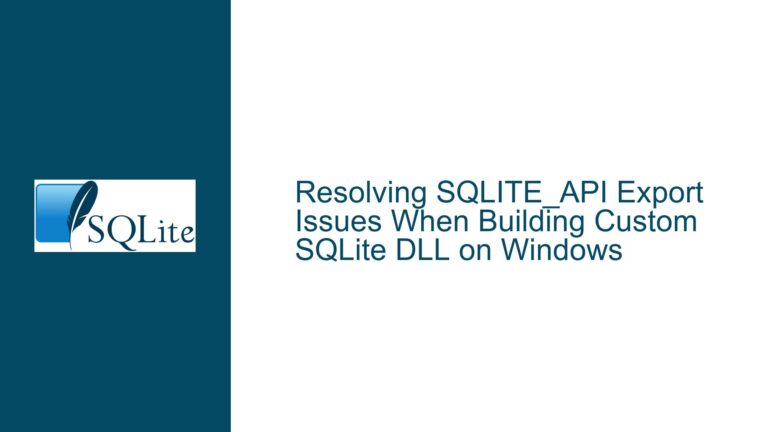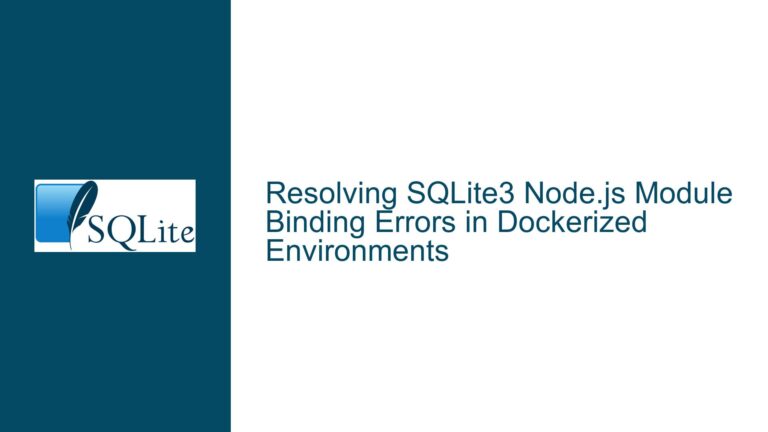Resolving VACUUM INTO Page Size Limitations in WAL Mode
Understanding the Interaction Between VACUUM INTO, Page Size Configuration, and WAL Mode
Issue Overview
The SQLite VACUUM INTO command is designed to create a new database file by reorganizing and optimizing the contents of an existing database. This command is particularly useful for creating compact, efficient copies of databases without altering the original file. However, a significant limitation arises when the source database operates in Write-Ahead Logging (WAL) mode. In such cases, the VACUUM INTO command is restricted from changing the page size of the newly created database, even though the operation involves generating a separate file.
This limitation stems from SQLite’s internal enforcement of page size consistency for databases in WAL mode. The original design assumes that altering the page size of a WAL-mode database could destabilize its transactional integrity or recovery mechanisms. While this restriction is reasonable for in-place modifications (e.g., standard VACUUM), it becomes unnecessary for VACUUM INTO, which generates a distinct database file. The new database should logically inherit only the structural optimizations from the source, not its runtime configuration constraints.
The core issue is that SQLite’s source code applies a blanket restriction on page size changes for WAL-mode databases, regardless of whether the operation affects the original database or a new one. This prevents users from leveraging VACUUM INTO to create databases with different page sizes—a critical requirement for optimizing performance, storage, or compatibility across systems.
Technical Constraints in SQLite’s Page Size Handling and WAL Mode
Possible Causes
WAL Mode’s Page Size Immutability
SQLite enforces a fixed page size for databases in WAL mode to ensure transactional consistency. The WAL journaling mechanism relies on shared-memory structures and atomic writes that are tightly coupled to the database’s page size. Altering the page size of an active WAL database could invalidate existing journal entries or disrupt concurrency controls.However,
VACUUM INTOdoes not modify the source database. It creates an entirely new file, which should logically allow independent configuration of the page size. The original codebase did not distinguish between operations that modify the source database (e.g.,VACUUM) and those that generate a new file (e.g.,VACUUM INTO). This oversight led to unnecessary restrictions on page size changes duringVACUUM INTOoperations.Code-Level Enforcement of Page Size Checks
The SQLite source filevacuum.ccontains logic to prevent page size changes for WAL-mode databases. Specifically, the function responsible for initializing the vacuum process checks the journal mode of the source database. If WAL mode is detected, the code explicitly resets the target page size to match the source, effectively blocking any attempt to reconfigure it.The relevant code segment in
vacuum.cis:if( sqlite3PagerGetJournalMode(sqlite3BtreePager(pMain)) == PAGER_JOURNALMODE_WAL ){ db->nextPagesize = 0; }Here,
db->nextPagesizerepresents the desired page size for the target database. Resetting it to0forces SQLite to retain the source database’s page size. This check occurs before determining whether the operation is a standardVACUUMorVACUUM INTO, thereby applying the restriction indiscriminately.Lack of Contextual Awareness in Page Size Configuration
The original implementation assumes that any vacuum operation—whether in-place or file-creating—must adhere to the same constraints as the source database. This fails to account for the fact thatVACUUM INTOgenerates a standalone database that could safely adopt a different page size without affecting the source’s WAL integrity.
Modifying SQLite’s Source Code to Enable Page Size Changes in VACUUM INTO
Troubleshooting Steps, Solutions & Fixes
Step 1: Analyze the Code Path for VACUUM Operations
The VACUUM command is processed in vacuum.c, where the sqlite3BtreeSetPageSize function configures the page size for the target database. The critical check for WAL mode occurs early in this process. To enable page size changes for VACUUM INTO, the code must differentiate between operations that modify the source database and those that create a new file.
Step 2: Introduce a Conditional Check for VACUUM INTO
The provided patch modifies the WAL mode check to apply only when pOut (a pointer to the target database filename) is NULL. When pOut is non-NULL (indicating a VACUUM INTO operation), the page size restriction is bypassed.
The modified code segment becomes:
if( !pOut && sqlite3PagerGetJournalMode(sqlite3BtreePager(pMain)) == PAGER_JOURNALMODE_WAL ){
db->nextPagesize = 0;
}
This change ensures that the page size reset occurs only during standard VACUUM operations, not during VACUUM INTO.
Step 3: Validate Page Size Configuration in the Target Database
After applying the patch, verify that the VACUUM INTO command respects the desired page size. For example:
PRAGMA page_size = 8192; -- Set desired page size
VACUUM INTO 'newdb.sqlite';
Use the sqlite3_newdb.sqlite 'PRAGMA page_size;' command to confirm that the new database has the configured page size.
Step 4: Test Transactional Integrity and WAL Compatibility
Ensure that the modified code does not introduce regressions:
- Perform concurrent reads/writes on the source database during
VACUUM INTOto verify WAL stability. - Confirm that the new database operates independently, with no residual ties to the source’s WAL files.
Step 5: Incorporate the Patch into Custom SQLite Builds
For users relying on custom SQLite builds, apply the patch to the vacuum.c file and recompile. For example:
patch -p1 < vacuum.patch
./configure
make
Step 6: Leverage Official SQLite Updates
The SQLite development team has integrated equivalent logic into the official codebase. Upgrading to SQLite version 3.37.0 or later will include this fix.
Step 7: Address Edge Cases and Performance Considerations
- In-Memory Databases: Ensure
VACUUM INTOfrom an in-memory database respects the!isMemDbcheck in the code. - Cross-Platform Compatibility: Validate that the new database’s page size aligns with filesystem block sizes for optimal I/O performance.
- Backup and Recovery: Use
VACUUM INTOwith adjusted page sizes to create optimized backups without disrupting live databases.
By following these steps, users can fully utilize VACUUM INTO to reconfigure page sizes even when the source database operates in WAL mode, unlocking greater flexibility in database optimization and deployment.






